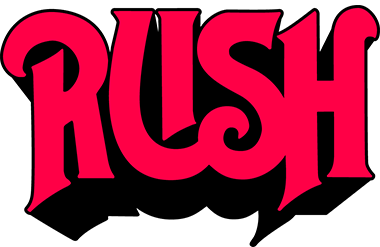LIVING ON THE LIGHTED STAGE APPROACHES THE UNREAL...

Click Any Image to Enlarge
Fondly known as the Holy Triumvirate, Rush is one of the greatest bands in rock 'n' roll history. From humble beginnings as a Toronto-area band playing middle school gymnasiums, churches, and coffee houses, Rush became one of the world's most sought-after live acts, selling out arenas around the globe. Alex Lifeson, Geddy Lee, and Neil Peart's ascent was a journey of perseverance. This official touring history covers that journey from 1968 to the final show in 2015. 
City by city, show by show, the band created a rabid fan base the hard way—through grueling, nonstop touring. Whether they were taking turns driving the van or jet-setting around the globe, Rush never lost sight of what made them great: the fans they played for. Laser focused on being a working band, they played for hours every night, with an ever-growing set list and stage show, for those adoring fans around the globe. Facing next to no media coverage, tepid album reviews, and the general disdain of the music world, Rush put in the work to keep the fans that kept coming back engaged and wanting more.
In these pages, you'll find set lists, opening acts, and noteworthy moments, all meticulously researched by the authors and vetted by the band members themselves. The definitive tour compendium for Rush fans, Rush: Wandering the Face of the Earth covers Rush's storied touring career with never-before-seen photographs and interviews from the people that were there.
CONTENTS
BY LES CLAYPOOL
INTRODUCTION: A MASTER CLASS IN 45 SHORT YEARS
BY HOWARD UNGERLEIDER
CHAPTER 1: ORIGINS
CHAPTER 2: THE RUSH TOUR
CHAPTER 3: THE FLY BY NIGHT TOUR
CHAPTER 4: THE CARESS OF STEEL TOUR
CHAPTER 5: THE 2112 TOUR
CHAPTER 6: THE ALL THE WORLD'S A STAGE TOUR
CHAPTER 7: THE A FAREWELL TO KINGS TOUR
CHAPTER 8: THE TOUR OF THE HEMISPHERES
CHAPTER 9: THE SUMMER TOUR '79
CHAPTER 10: THE PERMANENT WAVES TOUR
CHAPTER 11: THE FALL 1980 TOUR
CHAPTER 12: THE MOVING PICTURES TOUR
CHAPTER 13: THE EXIT . . . STAGE LEFT TOUR
CHAPTER 14: THE DEEP SOUTH SPRING TRAINING TOUR
CHAPTER 15: THE NEW WORLD TOUR
CHAPTER 16: RADIO CITY MUSIC HALL, 1983
CHAPTER 17: THE GRACE UNDER PRESSURE TOUR
CHAPTER 18: SPRING TRAINING 1985
CHAPTER 19: THE POWER WINDOWS TOUR
CHAPTER 20: THE HOLD YOUR FIRE TOUR
CHAPTER 21: THE PRESTO TOUR
CHAPTER 22: THE ROLL THE BONES TOUR
CHAPTER 23: THE COUNTERPARTS TOUR
CHAPTER 24: THE TEST FOR ECHO TOUR
CHAPTER 25: THE VAPOR TRAILS TOUR
CHAPTER 26: THE R30 TOUR
CHAPTER 27: THE SNAKES & ARROWS TOUR
CHAPTER 28: THE SNAKES & ARROWS LIVE TOUR
CHAPTER 29: THE TIME MACHINE TOUR
CHAPTER 30: THE CLOCKWORK ANGELS TOUR
CHAPTER 31: THE R40 LIVE TOUR
AFTERWORD
BY STEWART COPELAND
ACKNOWLEDGMENTS
LES CLAYPOOL

(excerpt)
"Who wants to go sturgeon fishing tomorrow?” I announced to the room. Ler LaLonde and I had been fixing up an old twenty-four-foot Sea Ray, and being that we had a day off between gigs, we were planning on hitting the bay. It was a little over a decade after that first Rush concert, and my band Primus was in the beginning of a tour supporting those three fellows from Toronto.
It was amazing to be playing nightly with Geddy, Alex, and Neil; even more so, it was surreal that we had, in a relatively short amount of time, become friends with guys who had been superheroes to us in our high school days. “I’ll go,” said Geddy. Had he seen the 1976 Sea Ray prior to showing up at the launch ramp, he may not have been quite as enthusiastic, but there she was the next day in all her glory with El Bastardo splayed across her stern in raised wooden letters. Ler and I had put in fresh indoor-outdoor carpet, enclosed her in green Sunbrella canvas, and repowered her with a new 351 crate motor, so it was much to our surprise when we heard a loud ZZZZPPPHHFFFTTTINGGG come from the engine compartment while motoring at full cruise across the bay. We’d thrown a fan belt, leaving us powerless halfway between the Berkeley Marina and the channel markers of San Quentin. I dropped anchor just off the northwest side of Red Rock, a small island in the south shadow of the Richmond–San Rafael Bridge. How many Rush-ites would crawl over broken glass in their underwear to take Geddy Lee out fishing in the middle of San Pablo Bay? I’ve often thought, Well, Ler and I did it . . . and got stranded to boot.
 Geddy was a good sport about the whole thing, actually videotaping me as I radioed the Coast Guard for the help that would never come. We killed the hours by catching a slew of small leopard sharks, but as the sun sank lower on the horizon, Geddy was beginning to get a bit twitchy. Here he was with a couple Rush-geek musicians in their early twenties that he’d just met a few days earlier, stuck in the middle of San Pablo Bay in the winter with no one responding to our radioed pleas for assistance. Eventually a fellow fisherman took pity and towed us, to the opposite shore, just in time for Geddy to hop in a cab and get to the dinner engagement in San Francisco that he had been nervously reminding us of. Ler and I then taxied to the auto parts store to get the belt needed to motor back across the bay, in pitch black, with Ler holding a flashlight and freezing his ass off on the bow. The next day as I’m walking through the hallway backstage of the Oakland Arena, I hear the familiar voice of Alex, goading me with the theme song from Gilligan’s Island.
Geddy was a good sport about the whole thing, actually videotaping me as I radioed the Coast Guard for the help that would never come. We killed the hours by catching a slew of small leopard sharks, but as the sun sank lower on the horizon, Geddy was beginning to get a bit twitchy. Here he was with a couple Rush-geek musicians in their early twenties that he’d just met a few days earlier, stuck in the middle of San Pablo Bay in the winter with no one responding to our radioed pleas for assistance. Eventually a fellow fisherman took pity and towed us, to the opposite shore, just in time for Geddy to hop in a cab and get to the dinner engagement in San Francisco that he had been nervously reminding us of. Ler and I then taxied to the auto parts store to get the belt needed to motor back across the bay, in pitch black, with Ler holding a flashlight and freezing his ass off on the bow. The next day as I’m walking through the hallway backstage of the Oakland Arena, I hear the familiar voice of Alex, goading me with the theme song from Gilligan’s Island.
We would go on to do three different tours with Rush, including a rare run through Europe. In the early nineties, a Rush fan was not necessarily the “hippest” thing to be, and in fact, we got quite a bit of flack from the press, especially overseas, for supporting those shows. We didn’t give a shit. Being a Rush fan was never about being “hip.” Besides, we were privy to the behind-the-scenes world of one of the most influential groups of rock musicians of the seventies and eighties. In my high school days, Rush were the musical barometer by which we young, eager fledglings set our standard, so to jam face-to-face with Geddy while Alex played guitar using a tortilla chip as a pick and Neil banged his sticks on the metal doors during one of our many locker-room backstage jams was pretty sweet.
Crouching behind Neil’s throne as he blistered away at his legendary drum solo in an arena full of punters; getting drunk in an outdoor caf. in Berlin and convincing the fellows to start playing “Cygnus X-1” live again; watching Alex put a bowl on Ler’s head and cut his hair—the stories go on and on. Had I been able to look into a crystal ball when I was sixteen years old and see that bit of my future, I would have surely soiled myself. So, when my manager emailed and said I had been asked to write the foreword to the new Rush book, I grew teary eyed with a sense of honor.
HOWARD UNGERLEIDER

(excerpt)
I was working for a talent agency in New York called American Talent International (ATI), run by Jeff Franklin, Sal Sapien, and Ira Blacker, when Rush signed with us. Ira Blacker, in particular, was keen on Rush and wanted to make sure that he placed somebody on the band's new management team that they would like. He asked me to go to Toronto and educate them to the ways of touring. Prior to that, in the early days of ATI, I had worked as a junior agent with many different acts (Savoy Brown, Deep Purple, Fleetwood Mac, Rod Stewart, Atomic Rooster, and Blue Oyster Cult, to name a few); I used to travel with the bands and make sure the contracts were adhered to. If there were problems getting a band paid, I would have to straighten it out. Lighting design and special effects were also longtime hobbies of mine. In short, I had lots of experience with what goes into the organizing and producing of tour travel and shows.
ORIGINS

(excerpt)
Over the course of their more than forty-year recording and touring career, Rush have sold millions of records and played on the largest stages, to capacity audiences, throughout the world. But the band's early history has remained relatively undocumented. Before their first official tour in 1974, Rush had been gigging around Toronto and southern Ontario for six years. Initially, the band performed primarily at drop-in centers and high school dances. When Ontario lowered the drinking age in 1971, Rush began playing in bars, and that was, by all accounts, when things became much more serious. By mid-1972 and throughout 1973, the guys — Geddy Lee, Alex Lifeson, and drummer John Rutsey — performed five to six nights per week. Meanwhile, Neil Peart was busy drumming in a wide array of bands prior to joining forces with Geddy and Alex in 1974. While Rush were not on tour, per se, during this period in the early '70s, they were working hard to build the foundation of the band.
STEWART COPELAND

(excerpt)
Somewhere in deep West Los Angeles is an industrial park that provides sanctuary for a curious man from a curious band. It's where Neil keeps his cars. A silver row of exotic period machines takes up most of the space, leaving a small, comfy seating zone and another corner where the brand-new, state-of-the-art motorcycles hang from hooks.
It's all so very Rush. For toys that are fun to mess with and examine with great curiosity, those Rush guys are old-school. Let it be the storied artifacts that get pride of place, more beautiful than practical.
But when the band saddles up, they go for the latest technology. Neil's motorcycles are not vintage Harleys. For hurling himself across continents, out in the elements at high speed, he entrusts his life to only the most precisely engineered models on the cutting-edge of locomotive design.






Rush: Wandering the Face of the Earth
The Official Touring History 1968-2015

